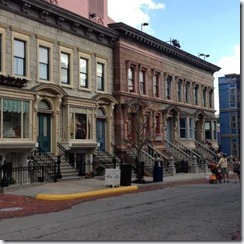Using Models for Settings
In creating the setting within a setting for your story, it’s helpful if you can model your site after one in existence. Then you can transplant the real place into your larger story and alter the details to suit your novel. Writers may find this easier than making up a site from scratch. It doesn’t work all the time but can be helpful when you find just the right place. Or sometimes, it’s a real place that inspires you to write the story.

This happened to me with EASTER HAIR HUNT, #16 in the Bad Hair Day Mysteries. The overall setting is Broward County, Florida. But the mystery itself takes place at Tremayne Manor, a historic mansion privately owned but open to the public for special events and guided tours.
I modeled this estate after Hillwood Estate, Museum and Gardens in Washington D.C. I’d been entranced by this former home to heiress Marjorie Post when we visited a number of years ago. We had delighted in having lunch at the café out by the formal gardens, strolling the manicured lanes and touring the historic house with its Russian treasures. I love this place, and so I transformed it into Tremayne Manor for purposes of my story. It helped that I had bought a booklet there describing the house and its contents.



Here’s an excerpt from my story:
Marla had only gotten a quick glimpse of the interior at her arrival. The entry hall at the front had faux stone walls, a crystal chandelier, and a grand staircase leading to the second level. Portraits of famous Russian royalty adorned the walls. Marla had gotten a kick out of it, since her own heritage went back to Russian aristocracy before the Revolution.
Voices rose in laughter from the dining room as Marla followed Lacey through a series of rooms. The guests appeared to be ignoring the turmoil outside. Then again, the action was happening back toward the tree line, so it might not be visible from their window view.
“I wish I’d taken the guided tour of your house,” Marla said as they passed into a room containing built-in, lighted display cases holding fancy porcelain dinnerware.
Lacey halted to regard her with a proud smile. “My husband’s grandmother became interested in Imperial art when she visited Moscow and St. Petersburg. Many of these pieces come from dessert services used by Catherine the Great. They bear the insignia of Russia’s most elite orders. The Queen would give dinners each year to honor the people who’d earned knighthoods.”
“These little cups are cute,” Marla said, examining a set emblazoned with silver stars.
“Those are my favorites. The ice cups were used for sorbets and custards, and I have a fondness for gelato. But come, I must see if this egg is truly from our collection.”
They passed through several rooms that would befit a palace with their ornate furnishings and valuable artifacts. Marla wondered why more security measures weren’t evident. She’d noticed the guard patrolling the interior, and each room had video monitors, but what about motion detectors and infrared lasers like she’d seen in movies?
Lacey headed directly to a tabletop display case in the center of one room. “Oh, my Lord,” she said, staring in disbelief.
“What is it?” Marla peered at a label that said the items in the case were made by Carl Fabergé, the famous jeweler commissioned by Russian royalty to make precious works of art. Three jeweled eggs rested on individual stands inside the glass case.
Uh-oh. One of them didn’t look right.
For SHEAR MURDER, I took one of our favorite places in Orlando named Harry P. Leu Gardens and transplanted it to fictional Orchid Isle as the site for a wedding. We’d strolled the lovely grounds at this fifty-acre botanical park and I used my memory, as well as a site map, to describe the intimate details in the story.




Reaching an intersection, Marla examined the signposts. Even though she had been here last night, she couldn’t remember which way to go. She aimed to find the Bride’s Cottage, where Jill was getting dressed.
Lugging her bag full of supplies, she swiped at her forehead, beaded with sweat. Her lavender gown swished about her ankles as she swatted an insect, cursing the humidity. She’d left behind the other bridal attendants, still primping in a private room across from the banquet hall. They had the benefit of air-conditioning, while she sweltered in the afternoon heat.
An evergreen scent pervaded the moist air, likely from the pine needles used as mulch. Colorful orchids mingled among the tropical foliage along with red crotons, pink pentas, and Chinese fringe flowers. Dense growth peppered the area, broken by a trickling stream. Alongside the path, green liriope acted as ground cover while moss-draped live oaks and laurel fig trees provided shade. Ferns, palms, and bromeliads competed for space.
The wedding would take place in the gazebo by the Rose Garden. Should she go left or right? She couldn’t remember if the wedding site was by the Floral Clock or the House Museum. Listening to birds twittering in the branches, she discerned voices coming closer.
“Chill out, babe. The ceremony hasn’t started yet. And anyway, I’m not the danged wedding photographer. My job is to cover the event in conjunction with the park’s debut, remember?”
“So why are you in such a hurry?” a sharp female voice replied. “It can’t be because you want to see the matron of honor, is it? Her husband is here somewhere. You wouldn’t want him to see you having an intimate tête-à-tête.”
“Get off my case, Hally. Focus on what you do best: observing other people and criticizing them.”
The couple rounded a corner and fell silent when they spotted Marla. Her quick glance detected the man’s scowl and the woman’s taut expression.
In my Drift Lords tale, WARRIOR ROGUE, I used Himeji Castle in Japan as a model for the enemy fortress in the story. I’d never visited, but I got the information I needed from the Internet. This castle fascinated me with its complexity. Short of visiting in person, I scoured online for layouts and details and then set my characters at the fictional Shirajo Manor.

At the top of the stairs, she spotted the manor, rising in the near distance. Multiple towers surrounded it. She assumed that site to be their destination.
Prodded in the back with a painful jolt, she stumbled forward toward another gate. Instead of opening to a path again, this door led inside a building.
“Leave the Drift Lord here.” Their commander indicated the wood plank floor in an empty room. The soldiers dumped him on the ground. “You four stay here and guard him until we get further orders. I’ll take the woman to General Morar.”
“What if she has the same power as the other one of her kind?” Gwarp said. He was the shortest among them with tufts of dark, spiked hair on his head. “We’ve heard rumors, Leytnant Bosk. If they’re true—”
“She would have already killed us. See for yourself.” Bosk squeezed her arm, making her wince in pain. “She’s nothing but a puny female.” The officer leered at her, his whiskers nearly poking her in the face. “Maybe the general will give her to me after he’s done questioning her.”
“Not if his wife has any say. Dr. Morar is likely to want this one for her experiments.”
“Too bad, then there won’t be anything left to enjoy.” Grasping Jen’s arm, Leytnant Bosk dragged her toward a spiral stone stairway. “Come, we have to get through this maug building before we can access the citadel.”
TRIMMED TO DEATH has a fall festival with a bake-off contest at a local farm. This was modeled after Bedner’s Farm in Boynton Beach. We’d explored this farmer’s market as well as the U-pick sites and this became Kinsdale Farms in the story.




The sun beat down on her head as she traipsed from one site to another without spotting her quarry. Francine didn’t seem to be anywhere around the main buildings or vendors’ alley. Marla had even sped through the petting zoo and kiddie area, peeking inside the bounce house.
Maybe Francine had taken refuge in the sparsely populated fields. The crowd tended to congregate near the festival tents. Soon the judges would gather on the makeshift stage to announce the winners from the day’s competitions. Country music from the band was still going strong, but the musicians should be winding down soon.
Wait, what about the open shacks behind the marketplace building? Marla had passed various sheds on her way in from the parking lot. They held empty crates, farm equipment, and a variety of tractors. Francine could be hiding in their vicinity. But when Marla tromped over, she didn’t see any sign of her target.
Had anyone else finished the game? Marla meandered over to the registration desk and asked the lady in charge. Nobody had turned in a finished card, the woman told her with a puzzled frown. Usually they had a winner by now.
A pit of worry gnawed at Marla’s stomach. Where could Francine have gone?
These are only a few examples. As you see, if you need to visualize a place where you will set a scene, it’s a lot easier when you have a real site in mind. Then you can alter the details to suit your story’s needs.
What are some places you’ve used as models in your books?
GIVEAWAYS
Reach for the Stars Giveaway, Sept. 1 – 14
Enter to win a signed first edition copy of Circle of Light and a polished hematite stone known for its calming influence. https://nancyjcohen.com/contest/

Booklover’s Bench, Sept. 1 – 18
Enter to win a free book from Booklover’s Bench at https://bookloversbench.com/win-a-free-book-september-2020/























